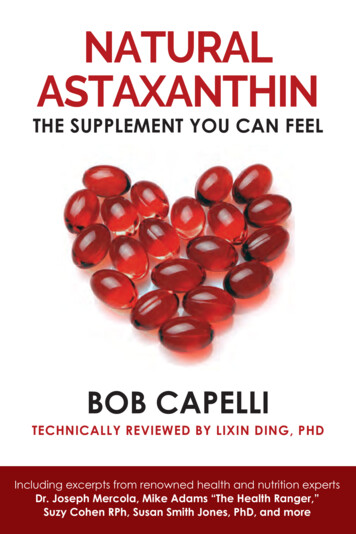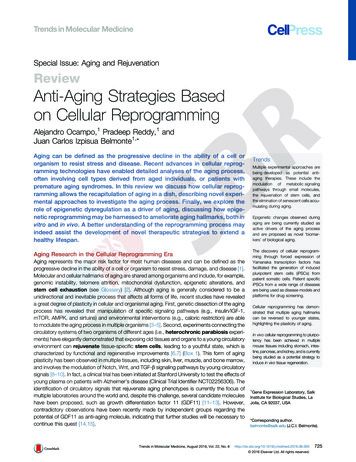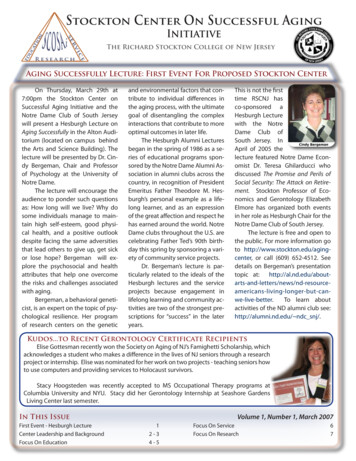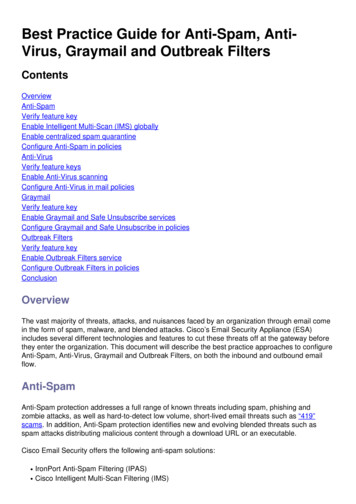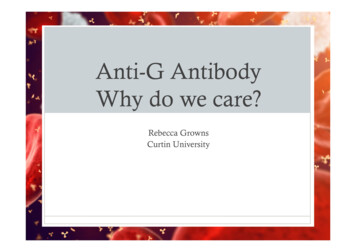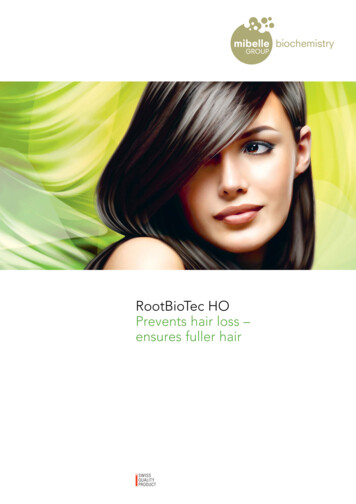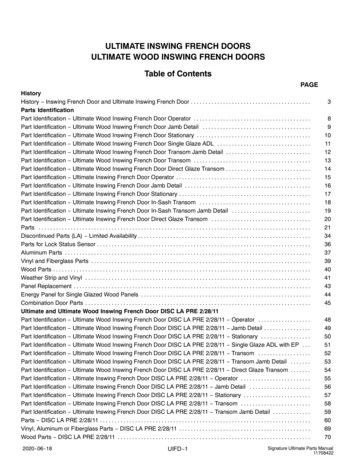
Transcription
Astaxanthin—the Ultimate Anti-Aging NutrientThe following White Paper on Astaxanthin’s diverse anti-aging properties isbrought to you by AlgaeHealth, a division of BGG. Please visit us atwww.algaehealthsciences.comAstaxanthin is perhaps the very best nutrient for anyone over the age of 40 to take on a dailybasis. The clinically validated benefits of Natural Astaxanthin in areas that most concern peopleas they age are quite comprehensive; practically every concern for people approaching middleage and beyond is at least to some extent addressed by this single supplement: Cardiovascularhealth, eye & brain health, skin health & UV protection, immunity, energy & strength levels,aches & pains, cellular health—research indicates that Natural Astaxanthin addresses all of theseand more. It is our opinion that every consumer over the age of 40 should be supplementingwith at least 4mg of Natural Astaxanthin every day. And even people under the age of 40 shouldconsider Astaxanthin as a great preventive supplement.At the very heart of Astaxanthin’s benefits against aging are its foundational properties of beingthe world’s strongest and highest quality natural antioxidant and being a safe and natural, broadspectrum anti-inflammatory. As a result of these attributes, Astaxanthin has demonstrated theability to protect our cells and the DNA within our cells from the onslaughts of oxidation andinflammation. In fact, these properties are the primary mechanisms of action from which mostof Astaxanthin’s varied health benefits emanate.In order to fully understand Astaxanthin’s benefits against aging, we will first review relatedresearch that shows anti-aging properties in each of the categories we mentioned above. Thisreview will focus on human research; however, in a few cases we will cite relevant pre-clinicalresearch (which will be limited to a small handful of studies). Then we will look at researchspecific to Astaxanthin’s ability to protect vital parts of our cells such as DNA and themitochondria. Lastly, we will round out this paper by examining Astaxanthin’s antioxidant andanti-inflammatory characteristics that further demonstrate its ability to protect the cells in ourbodies.
Human Clinical Research Reveals Anti-Aging Benefitsof AstaxanthinThere have been approximately one hundred human clinical trials showing a variety of healthbenefits for Natural Astaxanthin. Most of these areas of research are directly related to concernsthat people face in middle age and beyond. While a thorough review of all this research is notpossible within the confines of this paper, we will examine some of the most relevant areas ofresearch and delve into the most exciting research within each area.Eye HealthAs anyone who is 50 or older knows, the eyes change with age. Many people who neverrequired corrective lenses as children or in their 20’s and 30’s find themselves going to theoptometrist for a pair of reading glasses in their mid-40’s. And as people get older, much moreserious issues such as age-related macular degeneration, cataracts and glaucoma becomeincreasingly prevalent. What we need as an ounce of prevention for our aging eyes and brains isa combination supplement: A strong antioxidant and broad spectrum anti-inflammatory that canget through the blood-brain barrier and enter the brain. Then, once in the brain, it must be able toget through the blood-retinal barrier to bring its antioxidant and anti-inflammatory protection tothe eyes. Fortunately, Astaxanthin has exhibited these abilities in university and private researchwhich began over 60 years ago in Europe and has continued since then, primarily in the USA andJapan (Grangaud, 1951; Massonet, 1958; Tso and Lam, 1996; Capelli and Cysewski, 2014).There are several human clinical trials that validate a variety of eye health benefits; let’s examinesome of the best human trials that have shown Natural Astaxanthin’s diverse positive effects onthe eyes.Eye Fatigue, Eye Accommodation and Eye Strain. Eye fatigue (which is known medically as“Asthenopia”) is becoming more prevalent due to extensive use of computers and other visualdisplay terminals. This can manifest as eye strain, blurring and diplopia (a disorder of vision inwhich two images of a single object are seen because of unequal action of the eye muscles – alsocalled double vision). Accommodation is a critical function of the eyes. This is the process bywhich the eye changes optical power to focus on a particular object as the viewing distancevaries. An extensive series of human clinical trials have shown that Natural Astaxanthin haspositive benefits for all of these conditions.
An early study in this area was done in Japan. It was a state-of-the-art study—a double blind,placebo-controlled human clinical study. After four weeks of supplementation with 5 mg ofAstaxanthin per day (extracted from Haematococcus algae meal) the authors reported a 46%reduction in the number of eye strain subjects. They also found higher accommodationamplitude (the adjustment in the lens of the eye that allows it to focus) in subjects who usedvisual display terminals (Nagaki, 2002).The next study we’ll look at tested two different dosage levels of Natural Astaxanthin for eyefatigue. Results showed positive effects at 4 mg per day, but found a better result at 12 mg perday (Nakamura, 2004). This study showed that the optimum dose was above 4mg per day, butthere was no conclusion as to whether the optimum would be 12mg or somewhat higher orlower. Much of the research since then has centered on 6mg per day as the optimum dose foreye health.Another group of researchers found similar results in their own human clinical study. Thisdouble blind study was done to evaluate Astaxanthin’s effect on eye fatigue and visualaccommodation. Forty subjects were divided into placebo and treatment groups, with thetreatment group receiving 6 mg of Astaxanthin for four weeks. The results showed that threeseparate visual parameters were found to have statistically significant benefits from Astaxanthinsupplementation. This study established an optimum daily dose for eye fatigue of at least 6 mgper day (Nitta, 2005). A study the following year corroborated these results. This studyconcluded that taking 6mg of Natural Astaxanthin per day has the effects of reducing andpreventing eye strain and accommodative dysfunction (Iwasaki, et al, 2006). This study wasinteresting in the sense that it showed both a preventative as well as a therapeutic potential forAstaxanthin for eye conditions such as strain and accommodation.This preventative role is displayed in a clinical study done on subjects whose eyes were healthy,with no signs of fatigue or strain. Both the treatment and the placebo groups were subjected toheavy visual stimuli to induce eye fatigue, and it was found that the treatment group recoveredmore quickly. This clearly indicates that Natural Astaxanthin may serve not only to treat eyefatigue in those that already suffer from it, but also to prevent eye fatigue from occurring inhealthy people (Takahashi and Kajita, 2005).Additional studies have shown that 6 mg per day of Natural Astaxanthin supplementation forfour weeks can reduce eye soreness, dryness, tiredness and blurred vision (Shiratori, 2005;Nagaki, 2006; Capelli and Cysewski, 2014).Other Human Research. A study was done in Japan with subjects comprised of twenty yearold, healthy men. The treatment group was given 6 mg of Natural Astaxanthin per day for fourweeks. Statistically significant improvement was found in two different parameters—visualacuity (the ability to see fine detail) and depth perception. Depth perception in particular saw aremarkable improvement by 46% in the group supplementing with Natural Astaxanthin (Sawaki,et al, 2002).
It is very important to have sufficient blood flow to the eyes and the retina to ensure they arehealthy and functioning properly. A human clinical study examined the ability of Astaxanthin toimprove retinal capillary blood flow. Eighteen subjects were given 6 mg per day of NaturalAstaxanthin and another eighteen people were given a placebo. After four weeks it was foundthat the Astaxanthin group had improved retinal capillary blood flow as compared to the placebogroup (Yasunori, 2005). The final study we’ll review in this section showed a different benefitfor using Natural Astaxanthin related to blood flow. This double-blind, placebo-controlled studyexamined Astaxanthin’s effect on blood flow to the vascular layer of the eye. Increased bloodflow velocity was found in subjects taking Astaxanthin (Saito, et al, 2012). It appears thatAstaxanthin can increase blood flow and can also increase the speed at which the blood isflowing to the eyes.Brain HealthThe incidence of age-related neurological problems is one of the fastest growing health issuesfacing the world’s aging population. In fact, with the possible exceptions of skin cancer anddiabetes, we have seen the incidence of maladies affecting the brain increase quicker than anyother ailment over the last few decades. Certainly, a preventive food supplement that is safe andnatural that could help prevent age-related neurological issues would be a logicalrecommendation for everyone who is approaching middle age. Fortunately, according to somegreat research over the last few years, it appears that we may have found just that in NaturalAstaxanthin. There have been many pre-clinical studies on how Astaxanthin can support thebrain, eyes and central nervous system. In fact, animal research in this area began in the late1940’s in France and was published as doctoral theses by two scientists who were certainly wayahead of their time (Grangaud, 1951; Massonet, 1958). Limiting our review to human research,we’ll look at three of the recent studies showing benefits for our brains:All three of these human clinical trials were done in Japan, a country that has embraced NaturalAstaxanthin as an outstanding preventative supplement for several years already. The first studytook elderly subjects with age-related forgetfulness and administered 12 mg of Astaxanthin eachday for 12 weeks. The researchers found efficacy for age-related decline in cognitive andpsychomotor function (Satoh, 2009).The second study was randomized, double-blind and placebo-controlled in human volunteers.After 12 weeks at either 6 mg or 12 mg daily Astaxanthin dosages, subjects were found to havedecreased levels of phospholipid hydroperoxides (which accumulate in people suffering fromdementia), as well as improved erythrocyte antioxidant status. The researchers concluded thatAstaxanthin supplementation may contribute to the prevention of dementia in humans as we age(Nakagawa, et al, 2011).The last study we’ll review related to brain health incorporated a larger subject pool than the firsttwo studies. This randomized double-blind, placebo-controlled study took healthy people whowere either middle age or elderly who complained of age-related forgetfulness. The study
included 96 subjects who were randomly assigned to take either placebo, 6mg of NaturalAstaxanthin per day, or 12mg of Natural Astaxanthin per day. The study duration was twelveweeks; however, several tests were performed on the subjects every four weeks during the study.In this study, the 12mg dose appeared to work somewhat better than the 6mg dose.Improvements in cognitive tests such as the CogHealth battery score and the Groton MazeLearning Test were found to increase in the 12mg group, while a lower level of improvementwas noted in the 6mg group. The authors concluded, “The results suggested that Astaxanthinrich Haematococcus pluvialis extract improves cognitive function in healthy aged individuals”(Katagiri, et al, 2012).Aches & Pain: The Anti-Inflammatory Effects of AstaxanthinThere have been several human clinical trials showing that Astaxanthin reduces pain in joints,tendons and muscles in groups of patients suffering from chronic conditions as well as in healthyyoung men doing intense exercise. The variety of studies are strong support for NaturalAstaxanthin’s far-ranging anti-inflammatory effects—whether the pain is in the joints, thetendons or the muscles, Astaxanthin seems to be able to reduce it and make people feel better.But we must warn our Readers—don’t expect Astaxanthin to work fast. You’ll have to useAstaxanthin at least two weeks and more likely four to as much as eight weeks to get the desiredresults. Fortunately, although Natural Astaxanthin takes longer to work than prescription antiinflammatories and over-the-counter pain remedies, it is completely safe. It does not share theserious side effects that the quicker pain pills all have.The other point we must warn our readers about is this: About 15 – 20% of the people who takeAstaxanthin for pain don’t obtain their desired results. This isn’t very different from other antiinflammatory products you find in a drug store; most of those don’t work for 100% of the people100% of the time either. The reason this happens with Astaxanthin is most likely due to differentpeople’s bodies having a different capacity to absorb carotenoids. Astaxanthin is a carotenoid,the family of molecules that includes other health-giving nutrients like lutein, lycopene,zeaxanthin and the most famous carotenoid, beta-carotene. When absorption of carotenoids isstudied in humans, researchers find a huge disparity in people’s ability to assimilate them. Therange is massive—from about 5% absorption level up to over 90% absorption. So what isprobably happening when someone takes Astaxanthin for a few months and doesn’t feel areduction in pain is that they are most likely in the very low absorption range. Their body mayonly be absorbing 5% of the Astaxanthin in the capsule they’re taking. So even if they’re taking12mg per day (which is generally the upper level recommended by most brands), their body isn’tfeeling the effects because so little is getting into their bloodstream. Meanwhile, a person whosebody is absorbing at the upper end of the range is getting practically all the Astaxanthin theyconsume into their bloodstream where it can work its magic. This person could take as little as2mg – 4mg per day and get an excellent result for painful conditions. Fortunately, with over80% of people finding great results in the normal dosage range of 4mg – 12mg per day, andconsidering that these benefits happen without any dangerous side effects, there is little reasonfor most people to try other remedies that may be unsafe such as over-the-counter medications
and prescription anti-inflammatory drugs. Now, let’s examine some of the human clinical trialsshowing how Natural Astaxanthin can reduce aches and pain, increase mobility and generallyimprove the quality of life for people suffering from joint or tendon pain.Reduction of C-Reactive Protein. Before we get started looking at the painful conditionsAstaxanthin has been shown to reduce, let’s first look at the main test used to measureinflammation in our bodies. The marker used by doctors to measure how much silent (alsocalled “systemic”) inflammation is occurring in a person’s body is called C-reactive protein(CRP). Silent inflammation has been singled out as a leading cause of many different diseases,most of them life threatening. In fact, the two leading causes of death in most countries,cardiovascular disease and cancer, have both been attributed to silent inflammation. (As anexample, the American Heart Association has indicated that CRP levels may be a better indicatorof heart disease than cholesterol levels.) In addition to heart disease and cancer, neurologicalconditions such as Alzheimer’s and Parkinson’s, diabetes, ulcers, asthma and many more seriousdiseases are all closely linked to silent inflammation. And while silent inflammation does notcause people to feel pain, it is important to appreciate the effect of Astaxanthin in reducing silentinflammation to have a full understanding of its anti-inflammatory activities.A double-blind, placebo-controlled human clinical trial was done to test Natural Astaxanthin’seffect on CRP levels in healthy volunteers. The subjects took either 12mg per day of NaturalAstaxanthin or a placebo for eight weeks. CRP levels were measured before and after the eightweek supplementation period. Results were very good—in only eight weeks people takingAstaxanthin reduced their CRP levels by over 20%; meanwhile, people taking placebo saw aslight increase in their CRP levels (Spiller, et al, 2006a).A team of researchers from Washington State University led by long-time carotenoid researcherBoon Chew, PhD did a multi-faceted study on Natural Astaxanthin primarily to test its effect onthe human immune response. They used young women in this randomized, double-blind andplacebo-controlled study. They measured immune markers as well as DNA damage, oxidativestress levels and CRP. The results were positive on all markers. In fact, at a dose of only 2mgper day they found a statistically significant decrease in CRP levels after eight weeks ofsupplementation (Park, et al, 2010).In addition to the studies on CRP above, a company experimenting with Astaxanthin productionback in 2006 publicized a human clinical trial on patients with CRP levels that were high enoughto place them in a high risk category for cardiovascular disease. The patients took NaturalAstaxanthin or placebo for three months, after which their CRP levels were again measured.Nearly half of the people taking Astaxanthin fell out of the high risk category while none ofthose taking placebo did (Mera, 2006).Rheumatoid Arthritis. Rheumatoid arthritis is a much more debilitating disease thanosteoarthritis in most cases. This is a disease where the person’s immune system attacks itself, acondition called an “auto-immune” disorder. Rheumatoid arthritis is a chronic condition that ismore difficult for doctors to address than osteoarthritis. For example, many people who use
drugs to treat rheumatoid arthritis find them ineffective. And regrettably, as with mostprescription drugs, many people experience dangerous side effects.Fortunately, Natural Astaxanthin has been shown to be very effective in reducing pain andincreasing satisfaction with the ability to perform daily activities in these patients suffering fromrheumatoid arthritis. In this double-blind, placebo controlled study, people in the treatmentgroup took 12mg per day of Astaxanthin over the course of eight weeks. Results showed asteady trend toward improvement in both pain levels and satisfaction from the beginning of thestudy to a midway point after four weeks, and then increasing improvement during the last fourweeks of the study. During the first month, subjects found slight improvements on average. Butby the end of eight weeks, the pain scores had dropped by 35% and the satisfaction scoresimproved by 40% in the group taking Astaxanthin (Nir and Spiller, 2002a).Carpal Tunnel Syndrome. A disease with no cure, carpal tunnel syndrome (abbreviated as“CTS” and also known as “repetitive stress injury” in some countries) affects up to 2% ofAmericans at any given time. CTS is common among people working in repetitive situationslike cash register operators, some manual laborers and people working all day on computers.This is a debilitating condition that causes pain in the wrists. It also causes numbness and cansometimes even cause paralysis of the wrists. Treatment usually consists of putting splints onthe wrists to immobilize them. Doctors will try splints for a period of time, and if improvementdoesn’t occur the next step in most cases is wrist surgery. Regrettably, in many cases, surgerydoesn’t work well. This is a disease that obviously needs an alternative solution.Natural Astaxanthin may be just that—an alternative to surgery for people suffering from carpaltunnel syndrome. As we mentioned above, there is no cure for CTS. We want to make it clearthat Astaxanthin cannot cure this disease either; however, a clinical trial showed excellent resultsin treating the pain that CTS causes.Patients suffering from CTS were randomly separated into two groups. One group took 12mgper day of Natural Astaxanthin and the other group took a placebo. Similar to the study onrheumatoid arthritis, this study also lasted eight weeks with a mid-term assessment of pain levelsafter four weeks.Perfectly mimicking the results found by people with rheumatoid arthritis, the group of CTSsufferers taking Astaxanthin had good results after four weeks, but much more significant resultsafter the full eight-week course of treatment. Pain levels were measured as well as the durationof pain. After eight weeks, these dropped by 41% and 36% respectively. Some of the peopletaking Astaxanthin reported that they were able to make major changes in their lifestyle due tothe positive effects they experienced (Nir and Spiller, 2002b).Tennis Elbow (Tendonitis). We’ve seen that Natural Astaxanthin can help people with seriouspainful conditions like rheumatoid arthritis and carpal tunnel syndrome. Another painfulcondition that is very difficult for physicians to treat is tendonitis. Tendonitis can affect many
different areas of the body. An area that is commonly affected with tendonitis in athletes is thearms. And, perhaps the most famous instance of this is known as “tennis elbow.”The repetitive motion of hitting tennis balls with a racket can manifest as tennis elbow, whichcauses a loss of grip strength in the hands and pain while gripping objects in the hand. Theclinical researcher responsible for studying Astaxanthin’s effects on rheumatoid arthritis andcarpal tunnel syndrome did a different kind of study on people suffering from tennis elbow. Hisname is Gene Spiller, PhD. Dr. Spiller tested people’s grip strength and the pain in their handsfrom tennis elbow before and after Astaxanthin supplementation. Once again, he separated thetennis elbow sufferers into two different groups randomly. The first group took 12mg per day ofNatural Astaxanthin for eight weeks, while the other group took an identical placebo. Theresults for people supplementing with Astaxanthin were outstanding: On average, their gripstrength increased by almost double in only eight weeks. The average increase was 93% to beexact, and there was also a decrease in their self-assessment of pain in their hands. Dr. Spillerconcluded that using Natural Astaxanthin may alleviate pain and increase mobility. “Thisimprovement may greatly improve the standard of living for those who suffer from such jointdisorders” (Spiller, et al, 2006b).Joint Soreness After Exercise. The first human clinical trial to test Astaxanthin’s effectivenessagainst pain and inflammation was done on a different population of people than Dr. Spiller usedin his experiments. If you analyze Dr. Spiller’s excellent research, you find that he focused onpeople who were already living in pain—people suffering from chronic painful conditions likerheumatoid arthritis, carpal tunnel syndrome and tendonitis. A clinical trial performed at theUniversity of Memphis back in 2001 under supervision of Andrew Fry, PhD looked at NaturalAstaxanthin’s effect on healthy men who were performing strenuous exercise.This study used a much lower dose of Astaxanthin—only 4mg per day. Additionally, this studyran for a very short period of time—only three weeks. Dr. Fry wanted to see if Astaxanthincould help prevent the soreness that usually occurs after intense exercise. The men whoparticipated in this study were training regularly with weights. The subjects used a resistancetraining apparatus for strenuous knee exercises during the three week treatment period and tookeither 4mg of Natural Astaxanthin or placebo every day.The young men taking placebo had significant joint pain in their knees immediately afterperforming the exercises. This pain was tested 10 hours after the heavy exercises, and then againat 24 hours and 48 hours after. Whether immediately afterward or at the various test times up toand including 48 hours afterward, the pain persisted for those who took placebo. But the youngmen who were taking 4mg of Astaxanthin every day showed no change in knee soreness rightafter exercise. This pain-free state remained consistent at the three other test times of 10, 24 and48 hours after exercise (Fry, A., 2001). This is a fantastic result in particular when you considerthat the dosage was the lowest level commonly recommended and that the study only ran forthree weeks.As you probably remember from the studies on rheumatoid arthritis and carpal tunnel syndrome,after four weeks there was an improvement in pain levels, but it became much more pronounced
after eight weeks as the Astaxanthin concentrated throughout the body. In this study, the resultswere much quicker and at one third the dosage. The reason for this is not clear, but may have todo with the fact that the subjects did not start with painful conditions and were athletic. In anyevent, it is very important to understand that Natural Astaxanthin appears to both reduce pain inpeople who suffer from chronic conditions, but also prevents pain in people who are exercisingheavily. The implications for not only the millions suffering from arthritis and tendonitis butalso for athletes as well as regular people doing heavy work on a daily basis are extremelypromising.Muscle Soreness After Exercise. The trial that Dr. Fry did at University of Memphis wasoriginally focused on another painful condition. In fact, the main goal Dr. Fry had with the studywas to see if Natural Astaxanthin could help prevent the soreness in muscles that occurs afterdoing heavy exercise. This condition is called “Delayed Onset Muscle Soreness,” and it affectsathletes, weight lifters, people doing hard physical work, and perhaps most notably, weekendwarriors. Thankfully, the results he found about Astaxanthin preventing joint soreness are muchmore significant than his original goal. There is no doubt that joint pain caused by strenuousexercise is a much more serious condition than muscle pain that often occurs after a heavyworkout. Pretty much everyone has had muscle soreness after a tough day in the garden or along game of volleyball at the beach, and people are all highly aware that it’s just a temporarycondition that will go away in a couple days. But sore joints are a much more troubling issuethat are certainly a greater concern than normal muscle soreness.In any event, Dr. Fry did not immediately find a statistically significant result showing thatAstaxanthin could prevent muscle soreness. But years later, Dr. Fry reexamined the data andfound that in a subset of the subjects in this trial, Astaxanthin did have an excellent result inpreventing muscle soreness after heavy exercise. The people that were positively affected werethose whose muscles had high fiber content (Fry, et al, 2013). So basically, it appears thatNatural Astaxanthin can prevent joint soreness after heavy exercise in most people, but it canonly prevent muscle soreness after heavy exercise in some people.Cardiovascular HealthNatural Astaxanthin has been clinically validated to support cardiovascular and heart health.There are currently well over forty published medical research studies outlining Astaxanthin’scardioprotective properties. These properties may help people prevent heart disease and mayalso help people with heart disease to minimize their risk of a heart attack or stroke. There areseveral distinct potential cardiovascular benefits that have been demonstrated through thisextensive research (Capelli and Cysewski, 2014).The main focus of the human clinical research has been on Natural Astaxanthin’s ability toimprove blood lipid profiles by decreasing low density lipoprotein (LDL, bad cholesterol) andtriglycerides, and by increasing high density lipoprotein (HDL, good cholesterol). A human
clinical trial in Japan found a very promising effect on LDL (bad cholesterol) both in test tubesand in human volunteers. They began with an in-vitro test which showed that Astaxanthin dosedependently prolonged the oxidation lag time of LDL. The test was then repeated in humans atdoses ranging from as low as 1.8 mg per day to as high as 21.6 mg per day for fourteen days.This study found that all four doses positively affected LDL oxidation lag time—at 1.8 mg perday it was 5% longer; at 3.6 mg per day it was 26% longer; at 14.4 mg per day it was 42%longer; but at the highest dose of 21.6 mg per day the upward trend stopped and the lag time was31% longer. This suggests that the optimum dose for blood lipid profiles is significantly lessthan 21.6 mg per day. The researchers concluded that consumption of Astaxanthin “inhibitsLDL oxidation and possibly therefore contributes to the prevention of atherosclerosis” (Iwamoto,et al, 2000; Capelli and Cysewski, 2014).Another placebo-controlled human clinical study on 61 volunteers with mild hyperlipidemiashowed benefits for improving blood lipid profiles and also for increasing adiponectin in theserum. Doses were varied at 6mg, 12mg and 18mg per day over a 12-week supplementationperiod. Blood lipid improvements were seen in significantly increased levels of HDL (good)cholesterol and significantly decreased triglyceride levels (Yoshida, et al, 2008).In a human clinical trial done in Eastern Europe, researchers took men with high cholesterol andsupplemented them with 4 mg of Astaxanthin per day for one month. The average decrease incholesterol levels was excellent in such a short period of time: Subjects supplementing withAstaxanthin showed an average decrease of triglycerides of 24% and an average decrease inLDL cholesterol as well as total cholesterol of 17% (Trimeks, 2003).A randomized double-blind study was done on healthy men in Finland at the Research Instituteof Public Health to test the effect of Astaxanthin on lipid peroxidation. Subjects in the treatmentgroup were given 8mg of Na
Astaxanthin and another eighteen people were given a placebo. After four weeks it was found that the Astaxanthin group had improved retinal capillary blood flow as compared to the placebo group (Yasunori, 2005). The final study we'll review in this section showed a different benefit for using Natural Astaxanthin related to blood flow.


